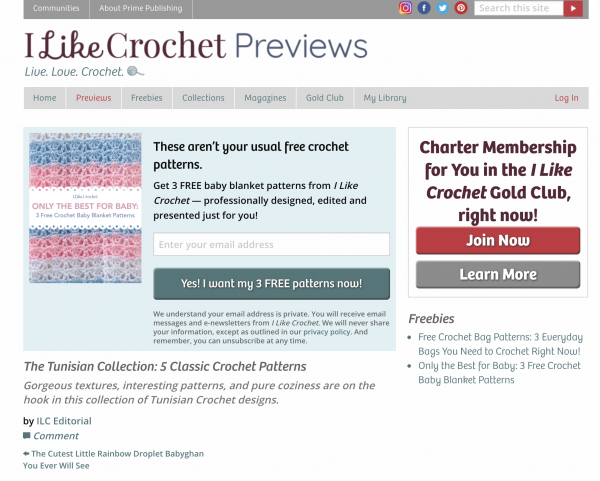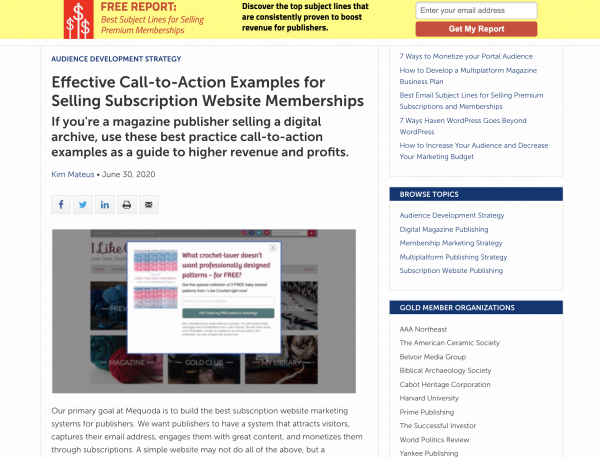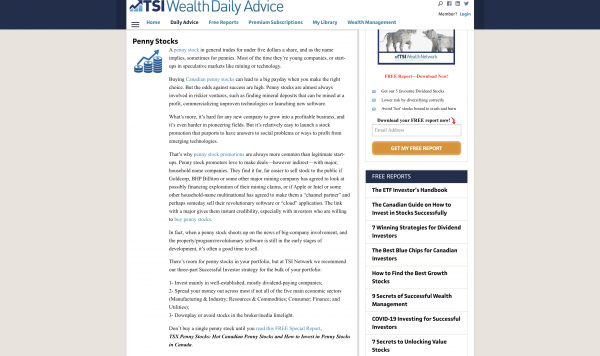
For decades upon decades, circulation directors had one goal and one goal only: increase magazine subscriptions.

If you’ve stepped into the brave new world of multiplatform magazine publishing, you have several new goals, including but not at all limited to:
- increasing digital magazine subscriptions
- increasing membership sales
- increasing one-shot product sales
- increasing website traffic
- increasing fans on Facebook, followers on Twitter and engagement on everything else
- increasing your email subscriber list
- … the list could continue forever to build a free and paid audience.
However, all these new revenue streams, and audience development efforts, mean that you have increased options for marketing your magazine, whether it’s print or digital, or both.
And there is one new task on the list above that can not only increase magazine subscriptions but also increase the sales of everything else in your brand wheel. If you double your email circulation, you can double your magazine subscriptions.
If you can effectively convert the masses of free visitors that arrive on your website into email subscribers, then you have their attention every day in the form of a newsletter, and can then convert them into magazine subscribers.
[text_ad]
Do you know your email capture rate?
 Your email capture rate (ECR) is a simple ratio and it tells you how many people who visit your site also convert to email subscribers.
Your email capture rate (ECR) is a simple ratio and it tells you how many people who visit your site also convert to email subscribers.
The ratio is this: The number of users (minus users coming from email) that come to your website during a 30-day period, divided into the number of users who join your database by signing up to receive your free email newsletter during that same 30-day period.
If during a given month you have 100,000 users (excluding users coming from email) that arrive at your website and 1,000 of these users become new email subscribers, your ECR is 1% (1,000/100,000 = .01 or 1%).
Most websites are more like .01% but our clients who execute an aggressive and smart conversion strategy average in the 1-2% range. If you’re not at least 1% then you have some work to do.
Any website analytics tool can measure your website users but projecting optimal email circulation requires a calculation.
- What is an acceptable ECR for your business goals?
- If you assume the ECR will be constant at that given percentage over 60 months, where will your email circulation level off?
The answer is a linear equation. The relationship between the ECR and email file size produces a straight-line graph when you hold all other variables constant. If you can double your ECR, you’ll double the size of your subscriber file over five years (or any fixed period).

How to increase your email capture rate to increase magazine subscriptions
Irresistible offers make it hard for visitors not to sign up. It all starts with your content. After reaching a point of satisfaction with your content, make an offer that’s worth the exchange of an email address. At the most basic level, we recommend giving away a free special report in exchange for your user’s email address.
Adopting 3C zone architecture, you will get the highest sitewide capture rate. These conversion architecture page elements come in the form of floater order forms, order forms in editorial and navigation (OFIEs and OFINs), display ads, text ads, and simple text links. If you’re using all six, you can see a capture rate of 1% or higher.
Because most publishers we’ve studied are only implementing one basic email capture element, they’re only seeing a 0.1% capture rate mentioned above. The following publisher examples are Mequoda’s publishing partners and have significant capture rates compared to their competitors, using these methods. If you want an even deeper dive, including mobile conversion elements, read our recent post on magazine call-to-action examples.
Floaters
Named a floater because it appears to float onto a webpage, they were created to fight back against pop-up blockers. While it may look like a pop-up, a floater does not open in a separate window and therefore cannot currently be blocked or banned. Learn more about using Floaters.
OFIE (Order form in editorial)
An OFIE is an embedded subscription form that appears on web pages to order a product or service, or more likely to sign up for an email newsletter. Most often they are right below the main navigation and right above an article, library preview, or other type of free content. They feature a free report cover and a simple email ask.

OFIN (Order form in navigation)
These online order forms appear in the right or left-hand navigation panels of a website. The customer/end user fills them out to order a product or service or to sign up for an email newsletter. The one below matches the site colors but stands out with a bold orange headline and button to download the free report.

Top Hat
One of the newer desktop capture units we’ve been testing is top hat ads. You might laugh at the color scheme, but when we tested, these “McDonald’s” colors outperformed a standard brand-aligned color scheme.
Text Ad
An online advertisement unit that uses text and text-based hyperlinks, without graphics. These are found within editorial content to sell a product or obtain an email address and usually stand out by having horizontal lines above and below the ad. More about writing text ads.
Text Links
Hypertext links in editorial or navigation lead to a Rapid Conversion Landing Page. These are the best form of persistent conversion architecture because they’re subtle, yet very effective ways to drive traffic to a Rapid Conversion Landing Page with the ultimate goal of increasing email database circulation. We use them often on Category Page and Tag Page descriptions.
The ultimate goal for the website publisher is to quickly and easily add unknown site visitors to an email database so you can increase magazine subscriptions, sell more books, sell more seats at events, and sell out the rest of your inventory.
Using floaters, OFIEs, OFINs, display ads, text ads, and simple text links on a website are relatively simple ways to improve the conversion architecture across your website network and improve your email capture rate so you can begin sending frequent editorial and promotional emails to increase magazine subscriptions.
We have many more ways to convert visitors into email subscribers, too. Learn more about increasing your email capture rate in our FREE handbook, How to Increase Your Audience and Decrease Your Marketing Budget.
What else would you like to know, or share, about increasing magazine subscriptions through website conversion architecture like the elements above?
[text_ad]






